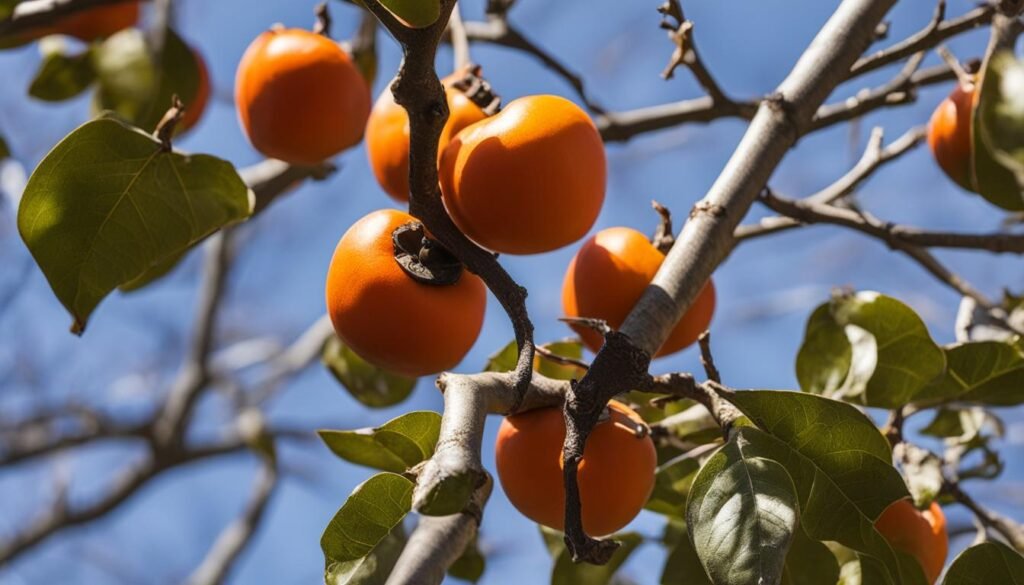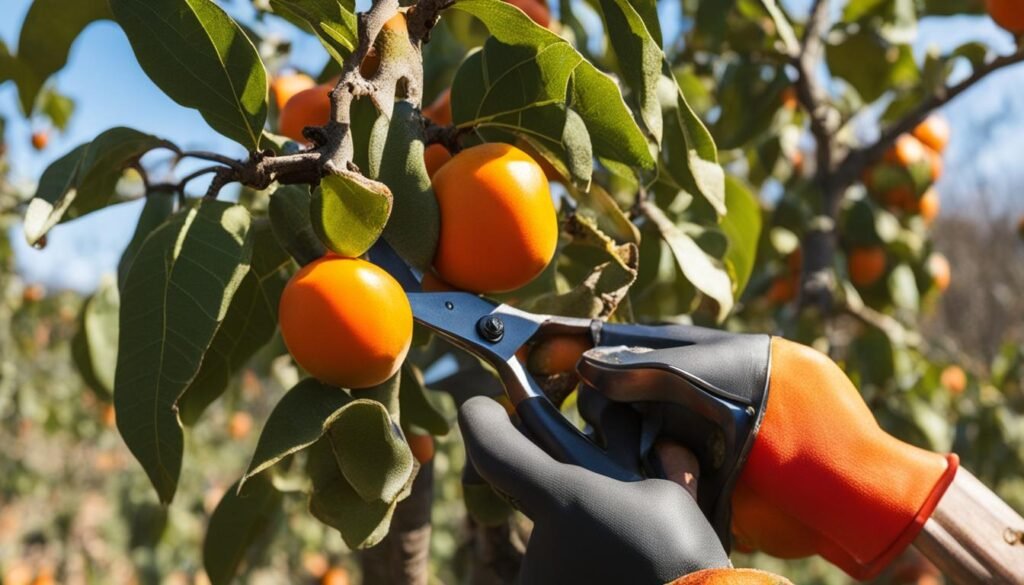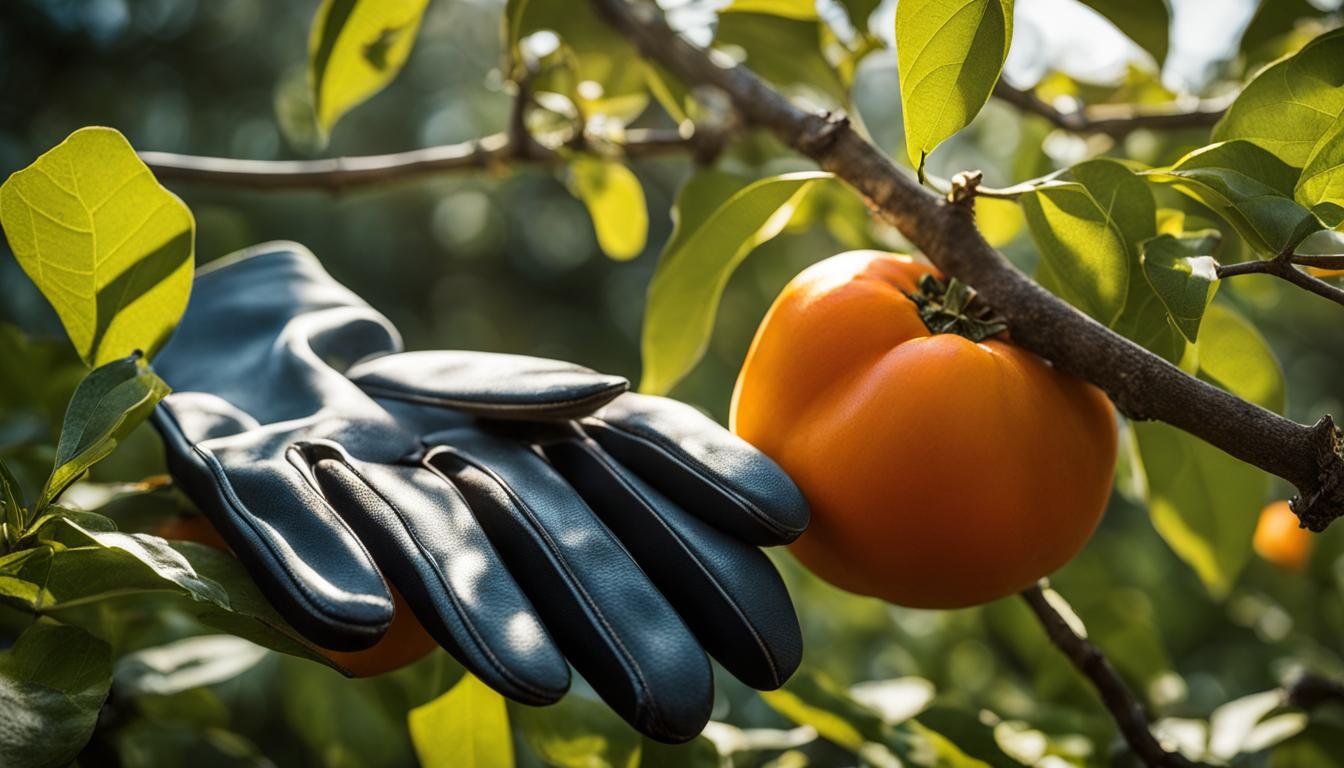Welcome, fellow gardeners! If you have persimmon trees in your garden or are considering adding them, then you’ve come to the right place. In this article, I will guide you through the art and science of pruning persimmon trees. Pruning is a vital skill that can help you maintain the health and productivity of your trees while shaping them to your liking.
Before we dive into the specifics of pruning, let’s explore the world of persimmon trees. These versatile gems can transform any garden into a vibrant haven. The most widely cultivated species is Diospyros kaki, also known as the Japanese persimmon. However, the American persimmon, or Diospyros virginiana, is native to the United States and deserves our attention as well.
When it comes to planting persimmon trees, selecting a site with ample sun and well-drained soil is crucial. Spring or fall is the ideal time for planting, allowing the trees to establish a healthy root system. But once your persimmon trees are planted, it’s important to understand how to care for them, and pruning plays a significant role in that.
Key Takeaways:
- Pruning persimmon trees is a skill that can improve tree health and productivity.
- Understanding the types of persimmon trees and their characteristics is essential for proper pruning.
- Plant persimmon trees in a sunny location with well-drained soil.
- Pruning should be done during the winter dormant period to avoid sunburn and promote healthy growth.
- Follow proper training systems and techniques to shape your persimmon trees to your desired form.
Types of Persimmon Trees
When it comes to persimmon trees, there are two main types that are commonly cultivated: the American persimmon (Diospyros virginiana) and the Japanese persimmon (Diospyros kaki). Let’s take a closer look at each type:
American Persimmon
The American persimmon is native to the United States and is known for its hardy nature. These trees can reach impressive heights, growing up to 60 feet. They have separate male and female trees, with small, fragrant flowers. The fruit of the American persimmon is pumpkin-shaped and ranges in color from pale orange to dark orange. It has a unique, sweet flavor that many people enjoy.
Japanese Persimmon
The Japanese persimmon, also known as Diospyros kaki, is a popular choice for cultivation in East Asia. These trees have glossy, bluish-green leaves that add beauty to any landscape. The fruit of the Japanese persimmon is more circular in shape compared to its American counterpart. It has a darker orange color and a deliciously sweet flavor. Japanese persimmons are highly prized for their culinary uses.
When deciding which type of persimmon tree to plant, consider your location, climate, and personal preference. Both the American and Japanese persimmons offer unique characteristics and can be a delightful addition to your garden.
| Type of Persimmon Tree | Height | Flower Type | Fruit Shape | Fruit Color |
|---|---|---|---|---|
| American Persimmon | Up to 60 feet | Separate male and female trees | Pumpkin-shaped | Pale to dark orange |
| Japanese Persimmon | Varies | Single tree | Circular | Darker orange |
Characteristics and Appearance
When it comes to the characteristics and appearance of persimmon trees, there are several key factors to consider. Let’s explore the tree size and growth, leaves and bark, as well as the flowers and fruits of persimmon trees.
Tree Size and Growth
Persimmon trees come in different sizes depending on the species. The American persimmon typically grows up to 10 meters in height, while the Diospyros kaki can reach heights ranging from 4.5 to 18 meters. These trees can add a majestic touch to any landscape with their impressive stature.
Leaves and Bark
The leaves of a persimmon tree are dark green and contribute to the tree’s lush appearance. When autumn arrives, the leaves transform into vibrant shades of yellow and orange, providing a stunning display of seasonal colors. As for the bark, it is gray to brown in color and often has a ridged texture, giving the tree a unique and textured look.
Flowers and Fruits
Persimmon trees have separate male and female trees, with the female trees bearing fruit. The flowers of these trees are small and inconspicuous, but they play a crucial role in the pollination process. Once pollinated, the fruit begins to develop. The fruits of persimmon trees come in various sizes, shapes, and colors depending on the species, ranging from pumpkin-shaped to more circular forms. They usually have vibrant orange hues and add a pop of color to the tree.
| Tree Characteristics | American Persimmon | Japanese Persimmon |
|---|---|---|
| Tree Size | Up to 10 meters | 4.5 to 18 meters |
| Leaf Color | Dark green to vibrant yellow and orange in the fall | Dark green to vibrant yellow and orange in the fall |
| Bark Color and Texture | Gray to brown, ridged | Gray to brown, ridged |
| Flower Color | Inconspicuous | Inconspicuous |
| Fruit Size, Shape, and Color | Pumpkin-shaped, orange | Circular, dark orange |
Overall, persimmon trees possess unique characteristics and a striking appearance that make them a captivating addition to any landscape. From their impressive size and growth to their vibrant foliage and colorful fruit, these trees are a delightful sight to behold.
Planting and Growing Conditions
When it comes to planting and growing persimmon trees, there are several key factors to consider. These include soil requirements, sun exposure and temperature, as well as watering and fertilizer needs.
Firstly, persimmon trees are adaptable and can thrive in various soil conditions such as clay, sand, and loam. However, they prefer slightly acidic soil with a pH of 6.0 to 6.5. Ensure that the soil is well-drained to prevent waterlogging, which can lead to root rot and other diseases.
Sun exposure is essential for the optimal growth and fruit production of persimmon trees. They require full sun, meaning at least 6 to 8 hours of direct sunlight per day. While they can tolerate some afternoon shade, it’s best to plant them in a location that receives ample sunlight throughout the day.
Regarding temperature, persimmon trees are hardy and can thrive in USDA hardiness zones 4-9. They can withstand cold winters and hot summers, making them suitable for a wide range of climates. However, it’s important to note that late spring frosts can damage flower buds and affect fruit production, so consider this when choosing the planting time.
| Planting and Growing Conditions | Requirements |
|---|---|
| Soil | Slightly acidic, well-drained soil (pH 6.0 – 6.5) |
| Sun Exposure | Full sun (6-8 hours of direct sunlight per day) |
| Temperature | Hardy in USDA hardiness zones 4-9 |
| Watering | Regular watering, especially when young |
| Fertilizer | Balanced slow-release fertilizer in early spring |
Watering is crucial for the establishment and growth of persimmon trees, especially during the first few years. Provide regular watering, ensuring that the soil is evenly moist but not waterlogged. Once the tree is established, you can reduce the frequency of watering, but continue to monitor soil moisture levels.
Fertilization can help promote healthy growth and fruit production. Apply a balanced slow-release fertilizer in the early spring, following the manufacturer’s instructions. Avoid over-fertilizing, as this can lead to excessive vegetative growth at the expense of fruit production.
By understanding and providing the right planting and growing conditions, you can ensure the long-term success and productivity of your persimmon trees.

Pruning Techniques for Persimmon Trees
Proper pruning of persimmon trees is essential for their health, shape, and fruit production. By utilizing the best practices for pruning persimmon trees, you can enhance the tree’s overall growth and maximize its fruit yield. Here are some techniques to keep in mind when pruning your persimmon trees:
1. Structural Pruning:
Structural pruning focuses on shaping the tree and maintaining its overall structure. It involves removing any crossed or crowded branches to create a well-balanced tree canopy. By promoting adequate air circulation and light penetration, structural pruning can help prevent diseases and maximize fruit quality.
2. Fruiting Wood Pruning:
To encourage fruit production, it is important to stimulate the growth of fruiting wood. Fruiting wood refers to the branches that bear fruit. Prune older branches that have already produced fruit and redirect the tree’s energy towards younger branches. This will ensure a continuous supply of fruit-bearing wood and improve the overall yield.
3. Disease and Damage Removal:
During the pruning process, it is crucial to remove any diseased, damaged, or dead branches. These can serve as entry points for pests and diseases, compromising the health of the tree. By promptly removing such branches, you can prevent the spread of diseases and maintain the overall vitality of your persimmon tree.
| Pruning Technique | Description |
|---|---|
| Structural Pruning | Focuses on shaping the tree and maintaining its overall structure. Involves removing crossed or crowded branches. |
| Fruiting Wood Pruning | Stimulates the growth of fruit-bearing branches to enhance fruit production. Older branches are pruned to redirect energy towards younger branches. |
| Disease and Damage Removal | Involves removing diseased, damaged, or dead branches to prevent the spread of pests and diseases. |

| Benefits of Pruning Persimmon Trees | Techniques for Pruning Persimmon Trees |
|---|---|
| 1. Promotes healthy growth | 1. Remove crowded or crossed branches |
| 2. Enhances fruit production | 2. Open up the center of the tree |
| 3. Improves airflow and light penetration | 3. Prune for structural stability |
| 4. Reduces the risk of disease |
By following these tree pruning tips, you can maintain the health and productivity of your persimmon trees. Remember to prune during the winter dormant period, avoid summer pruning, and selectively remove crowded or crossed branches. With proper pruning, your persimmon trees will thrive and reward you with a bountiful harvest of delicious fruit.
Pruning Persimmon Trees for Fruit Production
When it comes to maximizing fruit production in persimmon trees, proper pruning techniques are essential. Pruning helps create fruiting buds, position the fruit for easier harvest, and remove diseased or damaged branches. By following the right pruning practices, you can ensure the long-term health and productivity of your persimmon trees.
One key aspect of pruning persimmon trees is to stimulate the growth of new fruiting wood. This can be achieved by selectively removing branches that are old, unproductive, or crowded. By doing so, you allow more sunlight and airflow to reach the remaining branches, resulting in better fruit development.
In addition to shaping the tree and promoting fruiting, pruning also allows for the removal of any branches that are showing signs of disease, pest infestation, or physical damage. Regular pruning can help keep your persimmon trees healthy and reduce the risk of spreading infections or compromising the overall structure of the tree.
Remember to prune your persimmon trees during the winter dormant period, typically in January or February. This is when the trees are least active, making it easier to identify and remove any unwanted branches. Avoid pruning during the summer months, as this can lead to sunburn and damage the tree.

| Pruning Tips for Fruit Production | Persimmon Tree Care | Fruit Production of Persimmon Trees |
|---|---|---|
|
|
|
Proper Pruning Techniques for Other Fruit Trees
When it comes to pruning fruit trees, it’s essential to understand the specific techniques required for each type. Different fruit trees have unique growth habits and fruiting patterns, which influence the pruning methods necessary for optimal health and productivity.
Pruning Techniques for Pome Fruits
Pome fruits such as apples and pears produce fruit on spurs, which are short, stubby branches that form on older wood. To stimulate new growth and maintain a healthy tree, it’s important to prune pome fruits in late winter or early spring, before bud break. Remove any dead, damaged, or diseased branches, as well as any crossing or crowded branches. Focus on opening up the center of the tree to allow for better air circulation and sunlight penetration.

In pruning pome fruits, the goal is to promote fruit production, improve tree structure, and maintain a manageable size for easy harvest.
Pruning Techniques for Stone Fruits
Stone fruits such as cherries, plums, apricots, peaches, almonds, and pluots bear most of their fruit on small side branches rather than spurs. These fruits benefit from a different pruning approach to maximize fruit size and quality. Pruning should be done during the dormant season, just before bud break. Remove any dead, damaged, or diseased branches, as well as any suckers or water sprouts. Thinning cuts can be made to reduce the overall number of fruit, allowing the remaining fruit to grow larger and develop better flavor.
Pruning stone fruits involves shaping the tree, managing its size, improving air circulation, and maximizing fruit quality.
| Fruit Tree | Pruning Technique |
|---|---|
| Apples and Pears | Prune for spurs and open center |
| Cherries, Plums, Apricots, Peaches, Almonds, and Pluots | Prune for size control and improved fruit quality |
Understanding the proper pruning techniques for different fruit trees is crucial for promoting healthy growth, maximizing fruit production, and maintaining an aesthetically pleasing tree. By following these guidelines and adapting them to the specific needs of each fruit tree variety, you can ensure the long-term success and productivity of your orchard.
Conclusion
In conclusion, pruning persimmon trees is a vital aspect of persimmon tree care that can greatly benefit their health and productivity. By following proper pruning techniques, gardeners can shape these beautiful trees, encourage the development of fruiting buds, and remove any diseased or damaged branches.
It is crucial to prune persimmon trees during the winter dormant period, typically in January or February, to avoid sunburn and promote optimal growth. By understanding the characteristics of different persimmon tree species and their specific pruning requirements, gardeners can effectively maximize fruit production and ensure the long-term success of their trees.
Remember, over-pruning should be avoided, and it is essential to disinfect pruning tools between cuts to prevent the spread of diseases. By investing time and effort into proper pruning techniques, gardeners can enjoy healthy, productive persimmon trees that enhance the beauty of their gardens for years to come.
FAQ
When is the best time to prune persimmon trees?
Pruning persimmon trees should be done during the winter dormant period, usually in January or February.
How can pruning benefit persimmon tree fruit production?
Pruning persimmon trees can enhance fruit production by creating fruiting buds and positioning the fruit for ease of harvest.
What are some common pruning techniques for persimmon trees?
Common pruning techniques for persimmon trees include removing crowded or crossed branches, opening the center for light exposure, and repairing structural weaknesses.
How often should I prune persimmon trees?
Persimmon trees should be pruned regularly, ideally on a yearly basis, to maintain tree health and promote fruit production.
Can I prune persimmon trees during the summer?
It is important to avoid pruning persimmon trees during the summer to prevent sunburn on the exposed branches.
What are some tips for pruning persimmon trees?
Some tips for pruning persimmon trees include avoiding over-pruning, disinfecting pruning tools between cuts, and following proper training systems for young fruit trees.
Are there different pruning techniques for other fruit trees?
Yes, different fruit tree species may require different pruning techniques. For example, pome fruits like apples and pears produce fruit on spurs and require pruning to stimulate new growth.
When should I prune other fruit trees?
Pruning other fruit trees should also be done during the winter dormant period. The specific timing may vary depending on the fruit tree species.
How can I maximize the productivity and beauty of my persimmon trees?
By understanding the types of persimmon trees, their characteristics, and proper pruning techniques, gardeners can maximize the productivity and beauty of their persimmon trees.
What is the overall importance of pruning persimmon trees?
Pruning persimmon trees is an essential skill for maintaining tree health, promoting fruit production, and shaping the tree for easier harvest.




